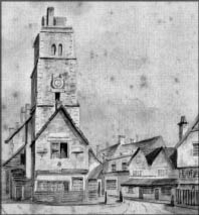Battlefield award for historic St Albans pub
Added: Thursday, August 1st 2013
One of Britain’s oldest and most historic pubs, the Boot Inn in St Albans Market Place, has been given special recognition as a “Battlefields Pub” as a result of its key role in the First Battle of St Albans that signalled the start of the Wars of the Roses. The pub has been “adopted” by the Battlefields Trust as it’s near the site of an important battlefield.
The first Battle of St Albans took place on 22 May 1455 and marked the start of the war between the houses of Lancaster and York. Parts of the Boot date back to the time of the battle, which resulted in a victory for the Yorkists. The second battle took place in and around the city in 1461 and this time the Lancastrians were successful and were able to release King Henry VI from captivity and restore him briefly to the throne. The wars went on for more than 30 years, culminating in the battle of Bosworth, when Richard III was killed, ending the Plantagenet reign.

Members of the Battlefield Trust presented landlord Will Hughes with an information panel that commemorates the inn’s location during the battles in St Albans.
The pub oozes history. I took two Belgian friends there for a drink and even though they live in Ghent, with its superb medieval and baroque buildings, they still marvelled at the Boot’s antiquity, with the ancient Clock Tower (pictured above) almost in touching distance and the Abbey Cathedral a few yards further on. The Boot is now a Grade II-listed building. It’s been altered and extended over the years but it still has impressive beams and standing timbers, old settles and open fires. The walls are decorated with images of St Albans past and present, including a painting depicting the First Battle of St Albans. It sends a shiver down the spine when you consider that all those centuries ago soldiers fighting in the streets of the city probably paused to drink ale in the Boot.
The buildings were extended in the 17th century and until the 1960s the pub shared the premises with a hairdresser. The Boot today is a modern pub in a historic building where father and son Will and Sean Hughes offer a wide range of beers from craft breweries both local and from further afield. It’s a different approach to the days when the pub was run by the large Watford brewery, Benskins, and it could sell only Benskins’ beers.
The pub is owned now by Punch Taverns but it gives the Hughes considerable freedom to choose their beers. Red Squirrel and Tring breweries often have their beers on the bar, and Oakham in Peterborough is usual present. The Boot is also a rare outlet these days for Draught Bass.
As befits the Boot, some of the beers have not just good taste but history as well. Lia Fail is Gaelic for the Stone of Destiny, while Bishop’s Farewell fits well in a city where the citizens had a turbulent relationship with the bishops in the abbey until their feudal power was summarily ended by Henry VIII.
Sean and Will have run the Boot for nine years. Will was keen to have a pub while Sean had learnt the food side of retailing when he worked in the Stable Doors restaurant in Welwyn. Father and son got together in St Albans and ran the Verulam Arms as well as the Boot for a while. They take a keen interest in helping the environment. Their waste is recycled and the use of electricity is kept to a minimum. There’s no central heating in the bar, which is warmed by the open fires. There’s live music on Sunday evenings and nourishing lunchtime food is made with ingredients sourced from farmers, vegetable growers and butchers. The specials on offer when I looked in were pea and mint soup and broccoli, Brie and bacon quiche. Main courses include Pie of the Day; beef goulash; macaroni cheese; local sausages with Dijon mustard mash, Guinness and onion gravy; ham, eggs, bubble and squeak; homemade quiche; and spicy chilli con carne.
But the Boot, as befits its history, is principally and primarily an ale house. The split between cask beers and lagers is 50:50 and Sean says ale outsells lager during the winter. Not surprisingly, the pub has been listed in the Good Beer Guide for several years.
Sean and Will are keen to go the extra mile and brew their own beer. They are going on a course at the Brewers’ Laboratory in Sunderland to learn the brewing skills and they say they have space both behind the main bar and in the extensive cellars to install brewing equipment – but they would have to negotiate with Punch Taverns to brew on site.
A brewery in the Market Place would restore a lost element of the city’s traditions. The Maltings shopping centre commemorates St Albans last major brewery, Adey & White, which owned 56 pubs. It was taken over and closed in 1936 by Green’s of Luton while Green’s – which had the dubious distinction of launching one of the first carbonated keg beers, Flower’s Bitter, in the 1950s – became part of the national Whitbread group.
I hope the Hughes’ plans are successful and we can look forward to Boot Bitter, Abbey Special and other beers they have in mind. My friends from Belgium will be duly impressed the next time they visit, though – with the Wars of the Roses in mind -- they will courteously remind me that John of Gaunt, the first Duke of Lancaster, came from their home town where he is known as Jan Van Gent.






